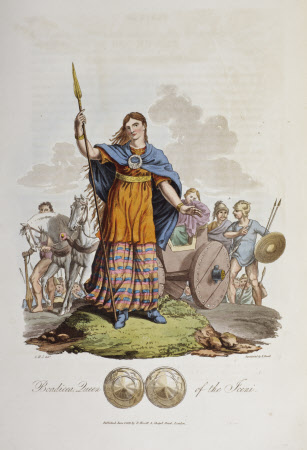The costume of the original inhabitants of the British islands, : from the earliest periods to the sixth century; to which is added, that of the Gothic nations on the western coasts of the Baltic, the ancestors of the Anglo-Saxons and Anglo-Danes. / By Samuel Rush Meyrick, ... and Charles Hamilton Smith. ...
Sir Samuel Rush Meyrick (1783-1848)
Category
Books
Date
1821
Materials
Place of origin
London
Order this imageCollection
Anglesey Abbey, Cambridgeshire
NT 3113992
Summary
Samuel Rush Meyrick and Charles Hamilton Smith, The Costume of the Original Inhabitants of the British Islands, London: printed by Howlett and Brimmer for T. McLean and E. Williams, 1821. Binding: Nineteenth-century full olive green straight-grained morocco over boards; blind fillets and tools to form a border; gilt cornerpieces; gilt and blind central panel with lozenge, blind centrepiece stamp and gilt floral tool; spine gilt, with title 'Costume of the ancient Britons'; sewn on five raised bands; gilt textblock edges.
Full description
‘The Costume of the Original Inhabitants of the British Islands’ represents a different kind of costume book from those dealing with contemporary metropolitan fashions or the exotic garb of other nations. At a time when antiquarians were rediscovering the art and architecture of the ancients, Samuel Rush Meyrick and Charles Hamilton Smith were turning their attention to their dress. The book was originally published in 1815 and followed a similar work by Smith alone, ‘Selections of the Ancient Costume of Great Britain and Ireland’ (1814), which covered the later period from the seventh to the sixteenth centuries. Its two authors came from very different back-grounds. Meyrick (1783-1848) was a graduate of the Queen's College, Oxford and an active member of the Society of Antiquaries. He practised as an advocate and wrote widely on antiquarian topics, with a particular interest in arms and armour. He assembled a large collection of this, building the lavishly Gothic Goodrich Court in Herefordshire partly to display it (having failed to purchase and rebuild the famous castle on the neighbour-ng hill). He advised on the arrangement of the armour collection in the Tower of London and was later knighted by William IV in recognition of his similar work at Windsor. His illustrated ‘Critical Enquiry into Ancient Armour’ appeared in three volumes in 1824. The Flemish-born Smith (1776-1859), by contrast, was largely self-educated. During a military career which took him to the Low Countries, Jamaica and North America, he amassed volumes of notes and watercolour sketches on topics including topography, natural history and archaeology, which formed the raw material of his many publications. As well as the two costume books mentioned above, these included works on military history and a number of zoological works illustrated from his own sketchbooks. He became a fellow of both the Royal Society and the Linnaean Society. In the preface to his ‘Selections of 'the Ancient Costume’, Smith had outlined something of a manifesto. He and Meyrick were aiming to demonstrate, to an age still apt indiscriminately to clothe its painted or sculpted images of great men in togas, that ‘far from diminishing the impressions intended to be conveyed, an adherence to the costume of the times represented will augment the illusion, and assist to explain the meaning’. Some of the pictures have a slightly theatrical quality, and both men would later act as advisers on historical costume to the leading actor-managers of the day, Smith to William Charles Macready and Edmund and Charles Kean, Meyrick to James Robinson Planché, who was himself to produce a number of works on the subject. The plates were drawn by Smith and aquatinted by Robert Havell (1769-1832), a member of a dynasty of artists, engravers and publishers who contributed to a large number of illustrated works of the period, most famously Audubon's ‘Birds of America’ (1827-39). The scholarly and well-referenced text was compiled, probably by Meyrick, from ‘three large quarto manuscript volumes’ of source material in his possession. A third ‘improved’ edition appeared, undated, some years later, by which time the aquatinting of the plates had in places quite worn away. Text adapted from William Hale's entry in ‘Treasures from Lord Fairhaven’s Library at Anglesey Abbey’, National Trust, 2013, cat. 32, pp. 106-7.
Bibliographic description
[6], 59, [1] p., [25] leaves of plates : col. ill. ; fol. Pencil "X" in margins on pp. 14 and 16. Tipped-in on front free endpaper: clipping from book dealer's catalogue describing this copy, with price cut out. Provenance: Twentieth-century armorial bookplate large variant, signed Badeley 1930: Urban Huttleston Rogers Lord Fairhaven [i.e.: Urban Huttleston Broughton (1896-1966)]. Ms. inscription on front pastedown: "42. R. Bo. M. [?]". Pencil markings on verso of front free endpaper: "K" and "111/-/-". Pencil note on rear pastedown: "152 Col. C". Binding: Nineteenth-century full olive green straight-grained morocco over boards; blind fillets and tools to form a border; gilt cornerpieces; gilt and blind central panel with lozenge, blind centrepiece stamp and gilt floral tool; spine gilt, with title 'Costume of the ancient Britons'; sewn on five raised bands; gilt textblock edges.
Provenance
Acquired by Huttleston Rogers Broughton, 1st Lord Fairhaven (1896-1966) and then bequeathed by him to the National Trust with the house and the rest of the contents in 1966.
Makers and roles
Sir Samuel Rush Meyrick (1783-1848), author Charles Hamilton Smith (1776-1859), author Charles Hamilton Smith (1776-1859), artist
References
Mark Purcell, William Hale and David Person, Treasures from Lord Fairhaven’s Library at Anglesey Abbey, Swindon: National Trust; London: Scala Arts & Heritage Publishers, 2013., pp. 106-7
